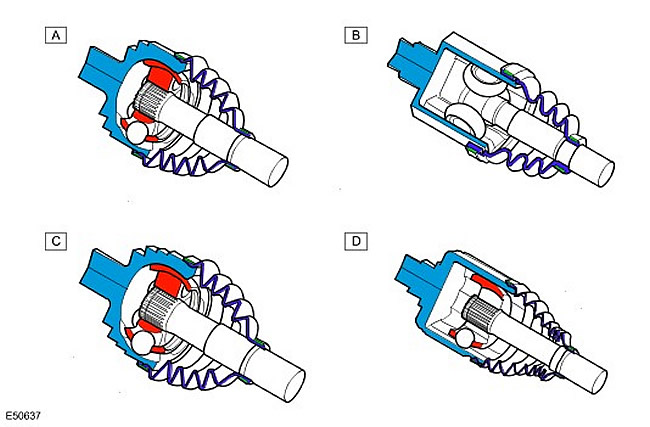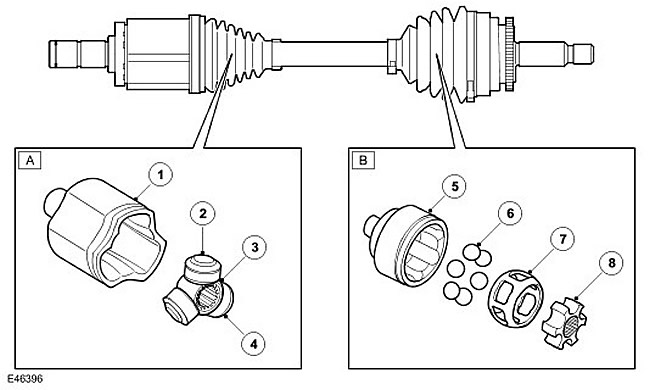
| Item name | Spare part number | Description |
| A | - | Front axle outer joint |
| B | - | Rear axle outer joint |
| C | - | Rear axle inner joint |
| D | - | Front axle inner joint |
The outer and rear inner CV joints are Bierfield joints (universal joints of constant angular velocity). This design uses elliptical grooves in which 6 steel balls are placed. The balls are additionally held by the body. Equal angular velocities are achieved by the position of the steel balls. If you pass the axle through the balls and the driven hub or differential shaft, then the two axles will always bisect each other at the drive angle. This allows you to transfer rotation from the drive shaft to the driven hub or differential shaft without loss of angular velocity and regardless of the angle of the shaft. The CV joints are filled with grease, which is held in place by a synthetic rubber boot. On each side, the cover is secured with a metal clip, which ensures tightness and does not allow moisture and dirt to penetrate into the hinge. CV joints are held on the corresponding shaft or pipe by an internal retaining ring. Retaining rings are located in the grooves of each shaft or at the ends of the pipes and enter the mating grooves of the CV joint.
ATTENTION: In the hinges of this type, the inner hub is not fixed in the hinge body. The hinge remains in an unsecured state and is held only by a cover. Thus, by pulling on the shaft, you can pull the hub out of the hinge housing. For this reason, care must be taken when dismantling and assembling the front drive shafts.
The shaft-to-outer tube connection is free-sliding, allowing for minor length changes that occur during suspension operation. The shaft enters a ball cage fixed inside the outer tube. The ball cage provides a rigid mounting of the shaft in the outer tube, while allowing it to move freely back and forth inside the tube if necessary. A sealing plug is pressed into the outer tube to keep grease around the balls in the cage.
Internal CV joints have the same design and principle of operation as external ones, except that they use rollers instead of balls to transmit rotational motion.

| Item name | Spare part number | Description |
| A | - | Internal CV joint |
| B | - | Outer CV joint |
| 1 | - | Tulip outer ring |
| 2 | - | trunnions (3 pcs.) |
| 3 | - | cross |
| 4 | - | Rollers (3 pcs.) |
| 5 | - | outer ring |
| 6 | - | steel balls (6 pcs.) |
| 7 | - | Frame (separator) |
| 8 | - | inner ring |
The front inner hinge is a tripod connection. Torque is transmitted from the outer ring to the connecting shaft by means of rollers rotating on bearing needles around the trunnions of the tripod joint cross. Roller tracks in the outer ring allow the tripod joint to move at an angle and along the axis inside the hinge.
The inner CV joint shaft has splines engaged with the splines of the front differential. This type of joint does not have an internal locking mechanism, so care must be taken when performing maintenance, otherwise the shaft and CV joint may separate from each other.
Comments on this article